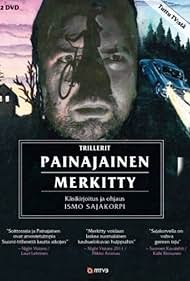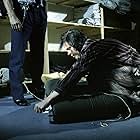I can remember there was true excitement in the air on those four nights in 1988 that Painajainen first aired. Horror, that most rejected of all film genres in Finland, seemed to finally have its big day on the small screen. While censorship and lack of finance had kept cinema practically horror-free for over thirty years and just as panicked cinema owners and calculating politicians were riding the hysteria wave to curtail the video market with one of the most restrictive home video laws in Western Europe, television offered an unlikely oasis for domestic horror to make an occasional appearance. Painajainen stood out in its day, got good viewing figures and was even awarded by the industry.
So how does Painajainen come across quarter of a century later on DVD? It certainly seems mostly like a taut and effectively made little chiller on a not-so-original template. Melasniemi's alcoholic artist wakes up from a seven-month coma with no memory of the months before the car crash that sent him there. He retraces his move to an isolated cottage in the country, and is soon confronted with nightmarish visions – or are they flashbacks? – of a young woman. She of course turns out to be a local tycoon's wayward daughter, who has been missing since the previous summer. Other usual suspects in the search for the truth about her disappearance include a sleazy teacher, a hulking voyeuristic simpleton protected by his long-suffering mother, a hot-headed young copper and a gregarious but authoritarian rural police chief. Even a psychic and a mother complex turn up to spice up the soup.
However, director-writer Sajakorpi vamps his familiar riffs with skill and sustains the suspense through the necessary twists and turns of the story. Though the use of 1980s videotape technology does impose certain visual flatness, he stages a few very atmospheric sequences and uses colour creatively. Also Penderecki's swirling masses of sound on the soundtrack come occasionally across as heavy-handed in their underlining assault, but they do help to infuse some of the scenes with true menace. Plundering modern art records for a score is just one of the many of the tricks and motifs that Sajakorpi first test-drove with 1984's one-off Merkitty. And of course he does deliver the necessary meat, though more as rather exploitative eroticism than as gore – on-screen nudity being far smaller a deal than graphic violence in Finnish television.
The cast are a bit uneven, but fortunately Melasniemi conveys perfectly and often with little dialogue the wide-eyed astonishment and fear of a man who is truly a stranger to himself and all the more tragic because he tries to understand and do the right thing. Also actress-author Härkönen creates one of the most memorable portraits of a spoiled, manipulative harridan in television history. Her character may be more archetypal than remarkable, but she plays it to the maximum effect.
I suppose the same can be said of Painajainen itself. Not the new dawn of Finnish horror it may have seemed like back then, it just makes the best of its resources and offers a reasonably gripping ride into darkness. It also became something like the culmination of Finnish television horror, as it has had few followers. Cinematic horror has persisted in the amateurs' delirious dreams and gory video fantasies, but only in the last few years has it started making tentative probes into the mainstream in films like Sauna and Rare Exports. Not dead but dormant and darkly dreaming, Finnish horror is yet to have its day.





